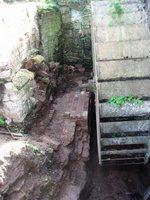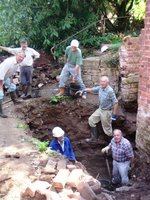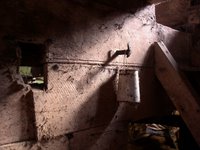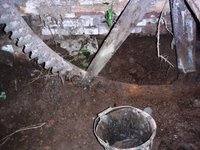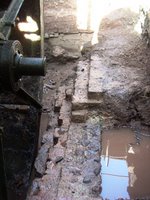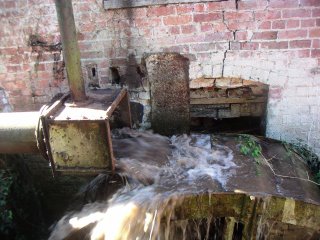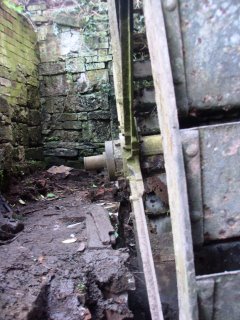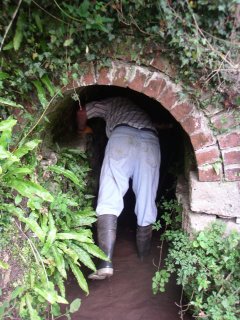Shelsley Watermill - X
We split into three pairs today and made an impression on the work.
One pair used the borrowed JCB to remove the stump of the laurel bush that used to overhang the front door of the mill. This laurel proved to be actually two bushes and they were both extremely tenacious. Some judicious digging and the appliance of a considerable amount of brute force did the trick in the end.
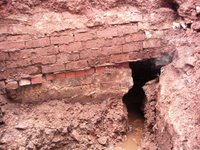 The second pair started to tackle the side of the culvert. Every time we look at this job we cringe. Somehow we have to support the brick built barrel roof of the culvert while we hack away the side nearest the mill, insert some sort of lintel and then make it all good and secure.
The second pair started to tackle the side of the culvert. Every time we look at this job we cringe. Somehow we have to support the brick built barrel roof of the culvert while we hack away the side nearest the mill, insert some sort of lintel and then make it all good and secure.
Passing builders have made comments like “Just use needles, it’ll be OK” and we are sure that they are right, but…
At least we now have a team member with some building experience who seems to understand about needles, basically scaffold poles inserted through holes knocked in the brickwork and taking the weight of the structure above while the structure below is knocked out and replaced. To us non-builders it still sounds dodgy but we will see.
The final pairing worked inside the mill trying to free off one of the stone nuts and the PTO gear so that when we do try to turn the wheel we won’t be trying to turn the whole works.
The stone nut is the gear wheel that takes the drive from the great spur wheel to a grindstone. They are intended to be able to be lifted up so that they no longer engage with the teeth on the great spur gear. One was left disengaged when the mill fell into disuse but the other is firmly on its boss with 80 or so years of rust holding it firm.
It’s still in place but soaking in penetrating fluid so it may move when we next try to shift it.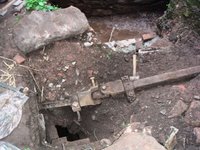
We had more luck with the PTO shaft and were able to leave this evening knowing that we can disengage and remove the whole shaft when we need to.
The Mill Society now has its own website, and this blog will transfer to www.shelsleywatermill.com in the near future. There will probably be a short period when postings appear in both places but I will soon get bored with doing this twice.
One pair used the borrowed JCB to remove the stump of the laurel bush that used to overhang the front door of the mill. This laurel proved to be actually two bushes and they were both extremely tenacious. Some judicious digging and the appliance of a considerable amount of brute force did the trick in the end.
 The second pair started to tackle the side of the culvert. Every time we look at this job we cringe. Somehow we have to support the brick built barrel roof of the culvert while we hack away the side nearest the mill, insert some sort of lintel and then make it all good and secure.
The second pair started to tackle the side of the culvert. Every time we look at this job we cringe. Somehow we have to support the brick built barrel roof of the culvert while we hack away the side nearest the mill, insert some sort of lintel and then make it all good and secure.Passing builders have made comments like “Just use needles, it’ll be OK” and we are sure that they are right, but…
At least we now have a team member with some building experience who seems to understand about needles, basically scaffold poles inserted through holes knocked in the brickwork and taking the weight of the structure above while the structure below is knocked out and replaced. To us non-builders it still sounds dodgy but we will see.
The final pairing worked inside the mill trying to free off one of the stone nuts and the PTO gear so that when we do try to turn the wheel we won’t be trying to turn the whole works.
The stone nut is the gear wheel that takes the drive from the great spur wheel to a grindstone. They are intended to be able to be lifted up so that they no longer engage with the teeth on the great spur gear. One was left disengaged when the mill fell into disuse but the other is firmly on its boss with 80 or so years of rust holding it firm.
It’s still in place but soaking in penetrating fluid so it may move when we next try to shift it.

We had more luck with the PTO shaft and were able to leave this evening knowing that we can disengage and remove the whole shaft when we need to.
The Mill Society now has its own website, and this blog will transfer to www.shelsleywatermill.com in the near future. There will probably be a short period when postings appear in both places but I will soon get bored with doing this twice.
